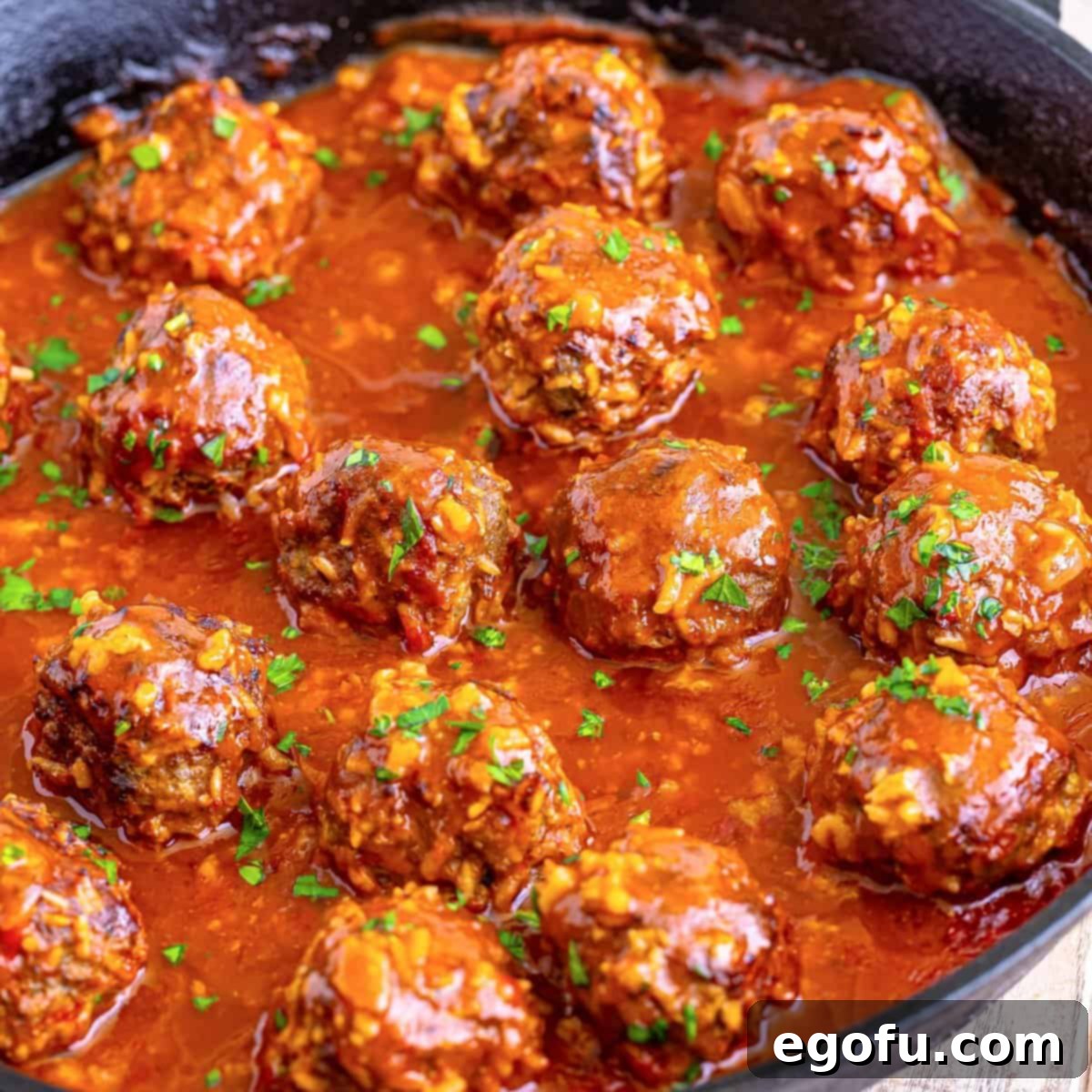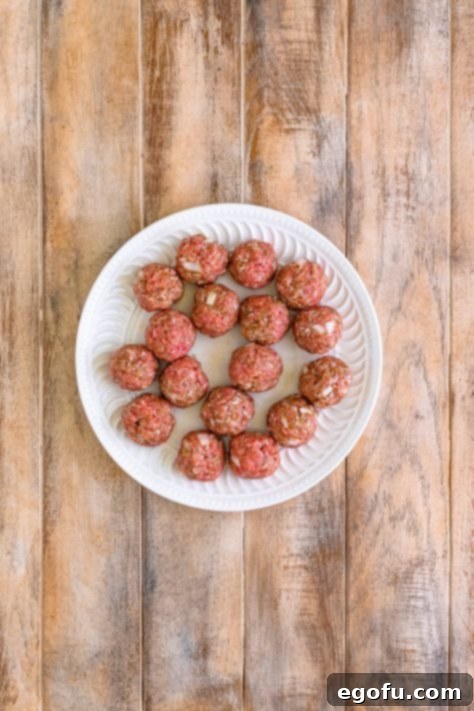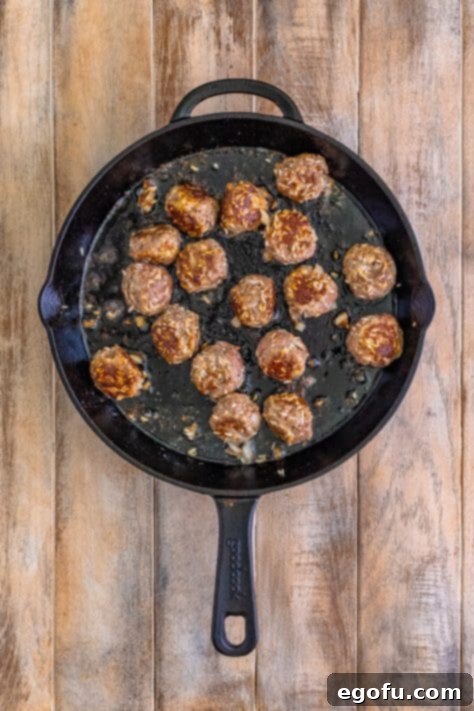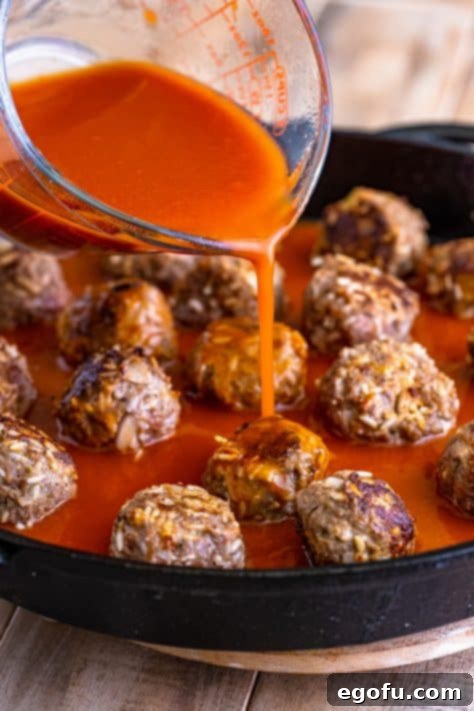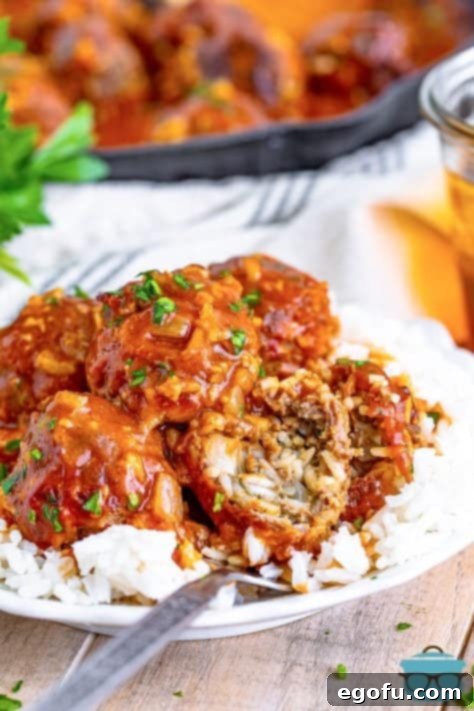Hearty, budget-friendly, and bursting with savory flavor, Porcupine Meatballs are a classic comfort food that’s both simple to prepare and incredibly satisfying. These versatile meatballs, featuring tender ground beef and rice simmered in a rich, zesty tomato sauce, are guaranteed to become a family favorite.
Classic Porcupine Meatballs: Your Next Easy & Flavorful Dinner
Have you ever experienced the unique charm of porcupine meatballs? Imagine perfectly seasoned, juicy ground beef mixed with uncooked rice, forming delightful bite-sized morsels. As they simmer in a vibrant tomato-based sauce, the rice grains plump up and peek out, giving these meatballs their distinctive “porcupine” appearance. It’s a culinary cleverness that not only adds visual appeal but also contributes to a wonderfully tender texture and a truly filling meal without being overly heavy.
This timeless dish is more than just a meal; it’s a nostalgic trip to home-cooked comfort, beloved by generations for its simplicity and robust flavors. Whether you’re a seasoned chef or a beginner in the kitchen, our recipe for Porcupine Meatballs promises an incredibly flavorful result that will have everyone asking for seconds. Get ready to add this deliciously easy go-to dinner to your weekly rotation!
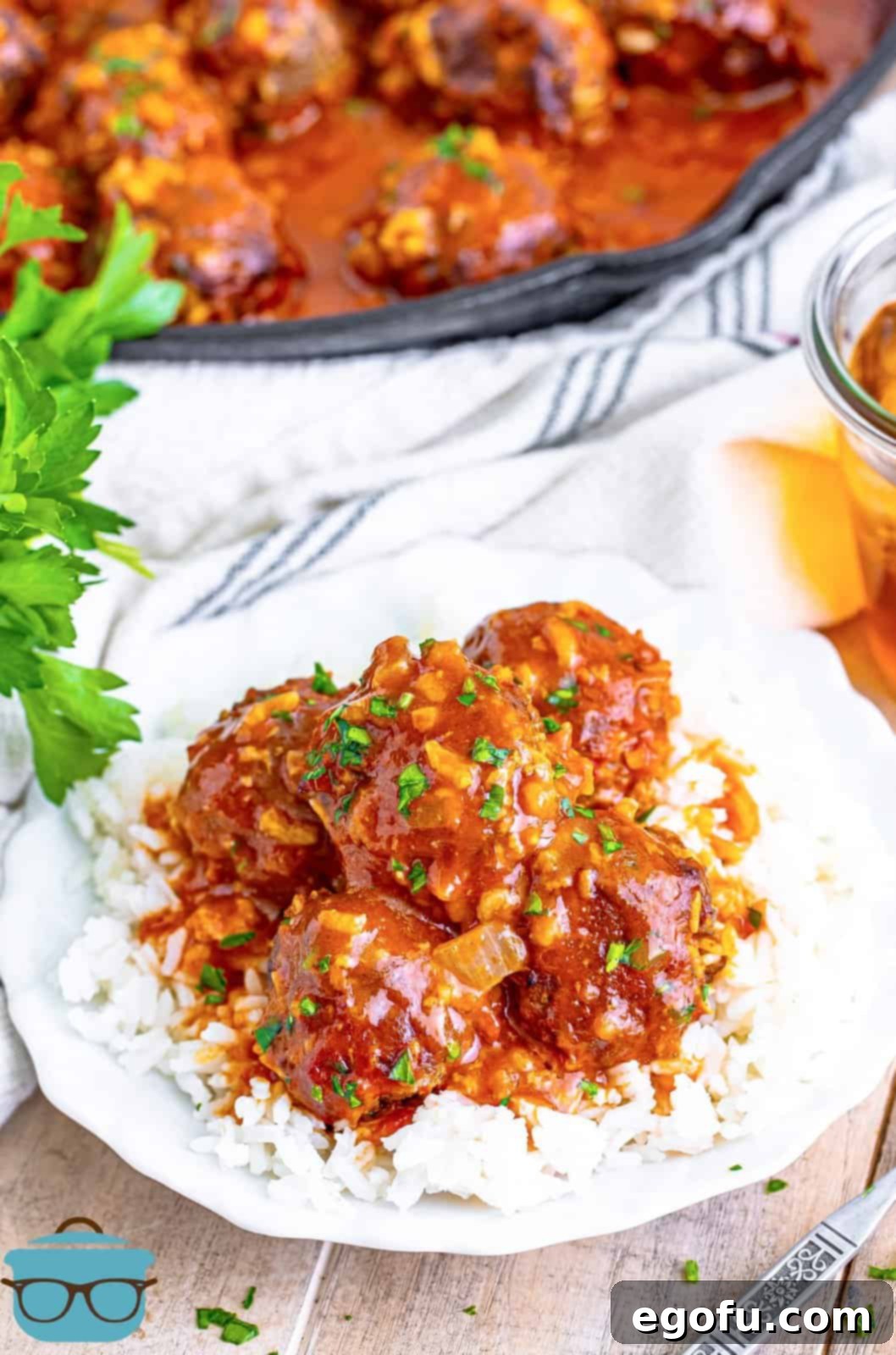

“Thank you for this yummy recipe! Toddler approved, monthly recipe on repeat! Can’t wait to impress guests with this, it is THAT easy and good!”
– Diana
Why You’ll Love This Porcupine Meatball Recipe
Beyond their charming name and unique appearance, porcupine meatballs offer a host of reasons to fall in love. They are incredibly **easy to make**, often requiring just one skillet for both browning and simmering, which means minimal cleanup. The combination of seasoned ground meat and rice creates a **hearty and fulfilling meal** that’s perfect for chilly evenings or busy weeknights. Furthermore, this dish is wonderfully **economical**, stretching your meat budget with the addition of rice, making it an excellent choice for feeding a family. With rich flavors and a tender texture, these meatballs are sure to become a beloved staple in your home.
Frequently Asked Questions About Porcupine Meatballs
What exactly are porcupine meatballs?
Porcupine meatballs are a classic American comfort dish primarily made from ground meat (usually beef) mixed with uncooked rice and various seasonings. These ingredients are rolled into balls and then slowly simmered in a savory tomato-based sauce. The name “porcupine” comes from the way the rice grains, as they cook and absorb moisture, expand and protrude slightly from the meatballs, resembling the quills of a porcupine. This dish gained popularity during the Great Depression as an ingenious way to extend meat supplies with inexpensive rice, making it both flavorful and filling.
What are the best serving suggestions for porcupine meatballs?
Porcupine meatballs are incredibly versatile and pair well with many side dishes. Traditionally, they are served over a generous bed of fluffy white rice, allowing the delicious tomato sauce to soak in beautifully. Other popular choices include creamy mashed potatoes or wide egg noodles, both excellent for catching every last drop of the rich sauce. To complete your meal, consider adding some vibrant steamed vegetables like carrots, peas, green beans, or broccoli. A fresh, colorful side salad also provides a lovely contrast and adds a touch of freshness to this comforting dish.
Can I use ground meat other than beef for this recipe?
Absolutely! While ground beef is the traditional choice, porcupine meatballs are highly adaptable. You can easily substitute ground turkey, ground chicken, ground pork, or even ground sausage for the beef. For an even richer flavor profile, feel free to use a combination of different ground meats, such as a mix of beef and pork, or beef and sausage. Ensure that regardless of your choice, the meat is fresh and of good quality to yield the best results.
What if I don’t own a cast iron skillet?
No problem at all! A cast iron skillet is excellent for even heating and retention, but it’s not strictly necessary. You can use any oven-safe skillet or Dutch oven that you have on hand. If you don’t have an oven-safe skillet, simply brown your meatballs in a regular skillet on the stovetop. Then, transfer the browned meatballs to a baking dish. Prepare the sauce separately in the skillet, bring it to a simmer, and then pour it over the meatballs in the baking dish. Cover the baking dish with foil or a lid and proceed with baking according to the instructions.
How do you prevent porcupine meatballs from falling apart during cooking?
The key to keeping your porcupine meatballs intact is incorporating a good binding agent. In this recipe, a well-beaten egg serves as the perfect binder, much like in a classic meatloaf. The egg proteins help to hold the ground meat and rice mixture together as it cooks, ensuring that your meatballs remain beautifully formed and tender. Additionally, avoiding over-mixing the meat mixture helps to keep the meatballs tender and less likely to crumble.
How should I store and reheat leftover porcupine meatballs?
Storing and reheating these meatballs is straightforward, making them excellent for meal prep! For short-term storage, place any leftovers in an airtight container and refrigerate for up to 3 days. To keep them longer, you can freeze them for up to 3 months. When it’s time to enjoy them again, leftovers can be reheated in a microwave for a quick meal, or gently warmed on the stovetop or in the oven until they are heated through. This ensures they retain their delicious flavor and tender texture.
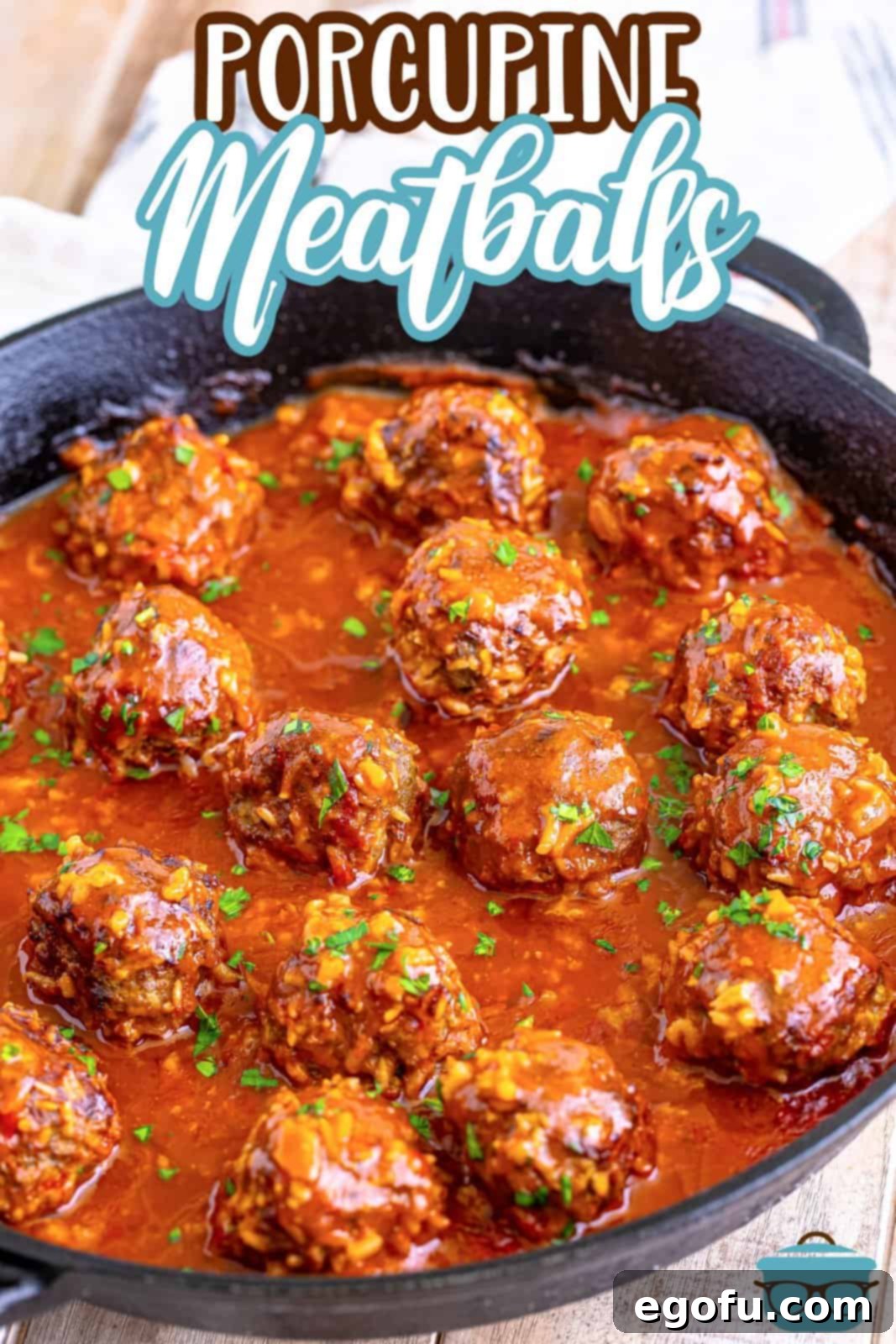
Essential Ingredients for Perfect Porcupine Meatballs
Crafting these delectable meatballs requires a handful of common pantry staples. Each ingredient plays a crucial role in building the signature flavor and texture of this beloved dish. Here’s a closer look at what you’ll need:
- Ground Beef: We recommend using a lean ground beef (like 90/10 or 85/15) to minimize excess grease. However, feel free to use ground turkey, ground chicken, or ground pork for a different flavor profile or lighter meal. A mix of ground meats also works wonderfully.
- Uncooked Long-Grain White Rice: This is the star ingredient that gives the meatballs their “porcupine” texture. Long-grain rice cooks up perfectly within the meatballs, absorbing the sauce and becoming tender. If you only have instant rice (like Minute rice) on hand, that can be used as well, though cooking times might slightly vary.
- Large Egg: The egg acts as a vital binder, helping to hold the meat and rice mixture together so your meatballs don’t fall apart during cooking. For best results and easier mixing, allow the egg to come to room temperature before incorporating it.
- Sweet Onion: Finely diced sweet onion adds a subtle sweetness and depth of flavor to the meatballs. If you’re not an onion fan, you can omit it or substitute with about a tablespoon of dried onion flakes for a milder taste.
- Worcestershire Sauce: A splash of Worcestershire sauce contributes a rich, savory, and umami depth that enhances the overall flavor of the meat. It’s a secret weapon for boosting meat-based dishes.
- Garlic Powder & Onion Powder: These pantry staples provide consistent, aromatic flavor that complements the beef and sauce beautifully. They ensure a well-rounded taste without the texture of fresh garlic or onion.
- Italian Seasoning: We love the slight herbaceous, aromatic notes Italian seasoning adds to these meatballs. It’s a subtle touch, not overpowering, but if it’s not to your preference, you can certainly leave it out or substitute with dried oregano and basil.
- Kosher Salt & Black Pepper: Essential for seasoning the meatballs and bringing all the flavors to life. Adjust to your personal taste.
- Condensed Tomato Soup: This forms the delicious, classic base of our rich tomato sauce. It provides a creamy texture and tangy-sweet flavor. For those with sodium sensitivities, opt for a low or no-sodium version.
- Beef Stock: Used to thin the condensed tomato soup into a luscious sauce, adding another layer of beefy flavor. Again, choose a low or no-sodium beef stock if you are mindful of salt intake; you can always add more salt later, but you can’t take it out.

Step-by-Step Guide to Making Porcupine Meatballs
Making these flavorful meatballs is incredibly straightforward. Follow these simple steps to create a hearty and comforting meal:
- Prepare Your Oven: Begin by preheating your oven to 350°F (175°C). This ensures your meatballs will bake evenly once transferred from the stovetop.
- Mix the Meatball Base: In a large mixing bowl, combine the ground beef, uncooked long-grain white rice, well-beaten egg, finely diced sweet onion, Worcestershire sauce, garlic powder, onion powder, Italian seasoning, kosher salt, and black pepper. Using your hands or a spoon, gently mix all the ingredients until just combined. Be careful not to overmix, as this can lead to tough meatballs.
- Form the Meatballs: Roll the mixture into approximately 2 Tablespoon-sized balls. The exact size might vary, but aim for consistency to ensure even cooking. Place the formed meatballs on a clean plate as you work.
- Brown the Meatballs: Heat 2 Tablespoons of vegetable oil in a large oven-safe skillet (such as cast iron) over medium heat. Once the oil is hot, carefully add the meatballs to the skillet, ensuring not to overcrowd the pan. Fry the meatballs for a few minutes on each side until they are golden brown all over. This step adds a crucial layer of flavor and helps them hold their shape. After browning, carefully wipe out any excess oil from the skillet.
- Prepare and Add the Sauce: In a separate bowl or large measuring cup, whisk together the condensed tomato soup and beef stock until smooth. Pour this mixture evenly over the browned meatballs in the skillet. Bring the sauce to a gentle simmer on the stovetop. Once simmering, remove the skillet from the heat.
- Bake to Perfection: Cover the skillet tightly with aluminum foil or an oven-safe lid. Transfer the covered skillet to your preheated oven and bake for 30 minutes. After 30 minutes, carefully remove the foil or lid and continue baking for an additional 30 minutes, or until the rice inside the meatballs is fully tender and cooked through, and the sauce has thickened slightly.
- Garnish and Serve: Once baked, remove the skillet from the oven. If desired, garnish with fresh chopped parsley for a pop of color and fresh flavor. Serve your delicious Porcupine Meatballs immediately with your favorite side dishes.


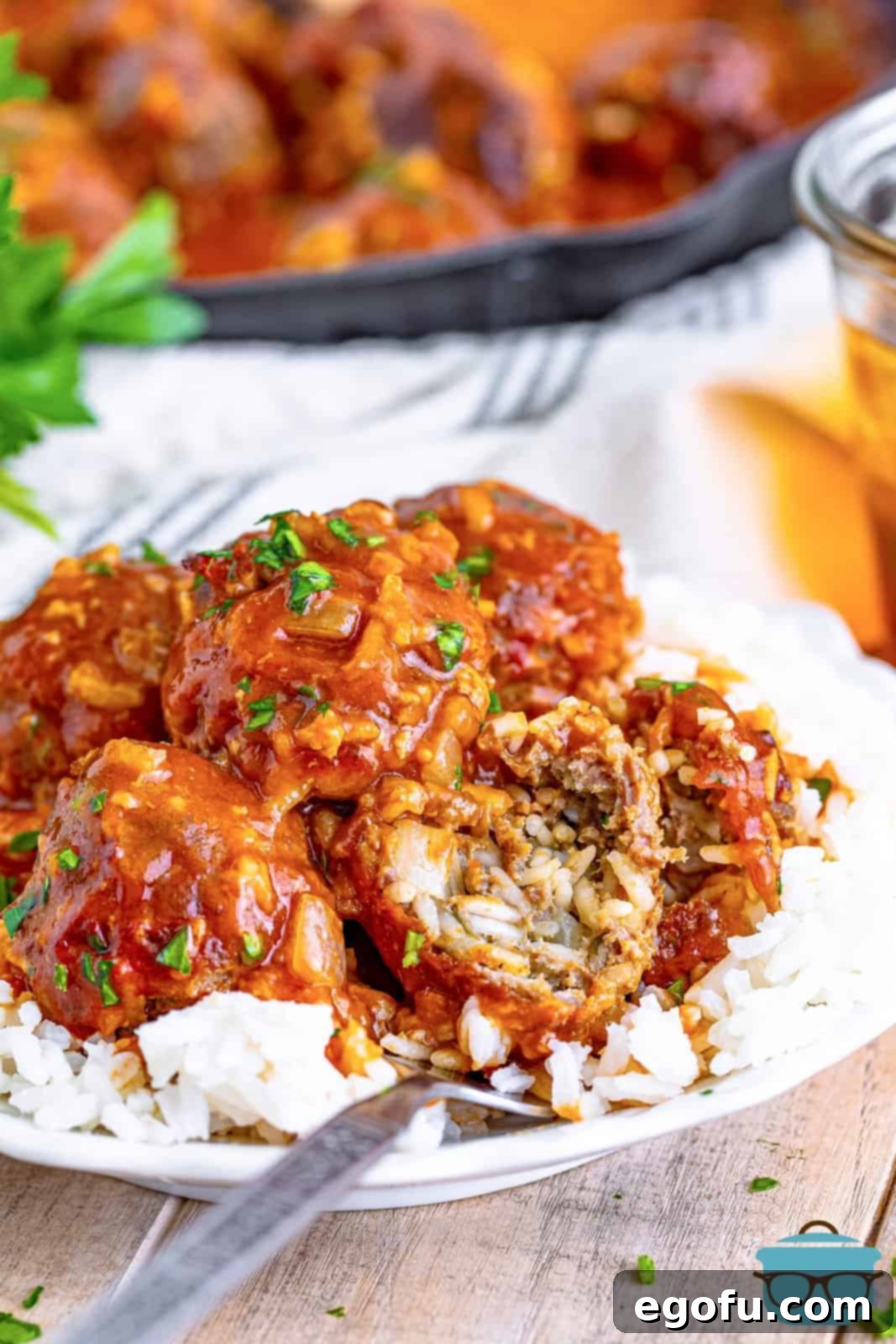
Expert Tips for Tender, Flavorful Porcupine Meatballs
Achieving perfectly tender and flavorful porcupine meatballs is easy with a few simple techniques:
- Don’t Overmix: When combining the meat, rice, and seasonings, mix just until all ingredients are incorporated. Overmixing can compact the meat, leading to a tougher texture.
- Room Temperature Egg: Letting your egg come to room temperature before mixing makes it easier to combine evenly with the other ingredients, ensuring better binding.
- Even Sizing: Try to make your meatballs roughly the same size. This helps them cook at the same rate, preventing some from being overcooked while others are still raw.
- Browning is Key: Don’t skip the browning step! Searing the meatballs on the stovetop before baking adds a deeper, richer flavor and helps them hold their shape better.
- Check for Doneness: The rice should be fully cooked and tender when the meatballs are done. If unsure, you can cut one open to check. The internal temperature of ground beef should reach 160°F (71°C).
- Adjust Seasoning: Taste the raw meat mixture (a tiny pinch, cooked quickly in the microwave, if you prefer) and adjust the salt and pepper as needed before forming the meatballs. Remember, you can always add more salt, but you can’t take it away!
- Low-Sodium Options: If you’re concerned about sodium intake, opt for low-sodium condensed tomato soup and beef stock. This gives you more control over the final salt content of your dish.
Craving More Delicious Meatball Recipes?
If you’re a fan of the comforting versatility of meatballs, you’ll love exploring these other fantastic recipes from our kitchen. From Italian classics to slow cooker wonders, there’s a meatball dish for every occasion:
- Chicken Piccata Meatballs
- Salisbury Steak Meatballs
- Chicken Parmesan Meatballs
- Crock Pot Honey Garlic Meatballs
- Crock Pot Swedish Meatballs
- Crock Pot Sweet and Sour Meatballs
- Crock Pot Grape Jelly Meatballs
- Air Fryer Meatballs
- Chicken Meatballs
- Homemade Italian Meatballs
- Bacon Wrapped Meatballs
- Crock Pot Ultimate Party Meatballs
- Homemade Turkey Meatballs
- Meatball Alfredo
Originally published: January 2023
Republished: March 2025

Porcupine Meatballs
Flavorful and tender, Porcupine Meatballs are a simple and filling go-to dinner. They’re versatile, hearty, and oh-so-delicious!
Ingredients
- 1 pound ground beef
- ½ cup uncooked long-grain white rice
- 1 large egg, well beaten
- ½ cup finely diced sweet onion
- 2 teaspoons Worcestershire sauce
- 1 ½ teaspoons garlic powder
- 1 ½ teaspoons onion powder
- 1 teaspoon Italian seasoning
- 1 teaspoon kosher salt
- ½ teaspoon black pepper
- 2 Tablespoons vegetable oil
- 10.75 ounce can condensed tomato soup
- 1 ½ cups beef stock
- Fresh chopped parsley (for garnish, optional)
Instructions
Preheat the oven to 350°F (175°C).
Mix 1 pound ground beef, ½ cup uncooked long-grain white rice, 1 large egg (well beaten), ½ cup finely diced sweet onion, 2 teaspoons Worcestershire sauce, 1 ½ teaspoons garlic powder, 1 ½ teaspoons onion powder, 1 teaspoon Italian seasoning, 1 teaspoon kosher salt, and ½ teaspoon black pepper in a large bowl. Mix gently until just combined.

Roll the mixture into 2 Tablespoon-sized balls and place them on a plate.

In a large, oven-safe skillet over medium heat, add 2 Tablespoons vegetable oil. Once hot, fry the meatballs for a few minutes on each side until golden brown. Wipe out any excess oil.

In a large measuring cup, mix together 10.75 ounce can condensed tomato soup and 1 ½ cups beef stock. Pour over the meatballs in the skillet and bring to a simmer. Take off the heat.

Cover with foil or a lid and bake for 30 minutes. Uncover and bake for an additional 30 minutes until the rice is tender.

Add fresh chopped parsley for garnish (optional), and serve immediately.

Notes
- We like to serve these meatballs over steamed rice, but they are also excellent over egg noodles or creamy mashed potatoes.
- You can customize the meat by using ground sausage, ground turkey, ground chicken, or ground pork in place of the beef, or any combination you prefer.
- Store leftovers in an airtight container in the refrigerator for up to 3 days. For longer storage, freeze them for up to 3 months.
- Reheat leftovers in the oven, microwave, or on the stovetop until thoroughly heated.
- While a cast iron skillet provides great heat distribution and often means only one pan to clean, any oven-safe skillet will work. If you don’t have an oven-safe skillet, simply brown the meatballs in a regular skillet, then transfer them to a baking dish. Prepare the sauce on the stovetop and pour it over the meatballs in the baking dish before covering and baking as directed.
Nutrition
Calories: 511kcal |
Carbohydrates: 33g |
Protein: 24g |
Fat: 31g |
Sodium: 1003mg |
Fiber: 2g |
Sugar: 8g
Nutritional Disclaimer
“The Country Cook” is not a dietician or nutritionist, and any nutritional information shared is an estimate. If calorie count and other nutritional values are important to you, we recommend running the ingredients through whichever online nutritional calculator you prefer. Calories and other nutritional values can vary quite a bit depending on which brands were used.
Did you make this recipe?
Share it on Instagram @thecountrycook and mention us #thecountrycook!
We hope you enjoy this comforting and easy Porcupine Meatballs recipe as much as we do. It’s a fantastic way to bring a hearty, homemade meal to your table without a lot of fuss. Happy cooking!
